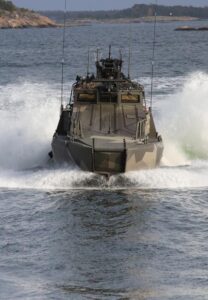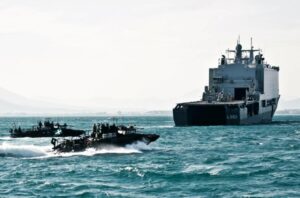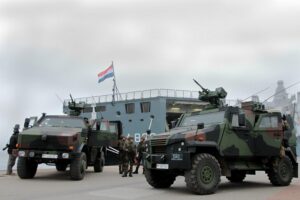Expansion of maritime capabilities through amphibious Combat boats
Early morning on the western edge of the Pacific: small teams of marines in company strength storm into their mobile Combat boats to remote islands. Supported by unmanned drones, the US Marines attack enemy landing ships and other warships with missiles before they can unload their invasion forces or advance into the depths of the Pacific. The missiles, which are Combat boats The generated target data is simultaneously passed on to the air force and navy. These support the defence campaign with long-range missiles. To avoid potential retaliatory strikes from the air, the Leathernecks change their location every 48 to 72 hours by jumping from island to island. In doing so, they utilise a new generation of amphibious Combat boatswhich can also be controlled remotely. The small and manoeuvrable patrol boats are difficult for the enemy to detect and engage, especially near the coast, due to their small signature.
What sounds like a scenario from a new Tom Clancy novel is actually the content of a current US Marine Corps (USMC) simulation game. The simulations conducted there show that new tactics and defensive combat with small amphibious boats would create "a lot of problems" for attacking enemy forces in the future, according to General David Berger, acting commander of the USMC. "It's very difficult (...) to counter a dispersed naval expeditionary force that's small and mobile," Berger said in an interview with the Wall Street Journal in March 2020. Critics, meanwhile, criticise him for arguing that his approach only applies to combat in the Western Pacific with its numerous island chains, i.e. only for a specific region.
Not a new approach

The fact that Berger's approach is not new and that his theories can also be applied to other regions of the world - and in particular to the Baltic Sea - is shown by the example of the Swedish and Finnish coastal hunters. The amphibious Nyland Brigade of the Finns and the Royal Amfibieregementet (Amf 1) have been working together in a binational amphibious task unit for a long time. Mobile strike teams have been training hit-and-run tactics with different types of combat boats for years. The geography of the eastern Baltic Sea, with its numerous rugged islands, archipelagos, jagged rocks and fjords, is figuratively similar to that of the Western Pacific. The Scandinavians use steep-fire weapons such as mortars, light missiles such as Hellfire and Spike-ER, reconnaissance sensors and combat swimmers as well as mines to practise fighting an enemy that invades their territory. Small mobile teams jump from island to island.
And the regions are not only geographically similar: For just as the US Marines are expected to operate successfully in the Western Pacific despite a superior enemy missile shield, their Scandinavian and Baltic counterparts must survive within an enemy missile bubble operating from the heavily armed Russian oblast of Kaliningrad. With regard to the situation in the Baltic Sea, the Russian Federation's A2/AD (Anti-Access/Area Denial) capability has already been reported on extensively elsewhere. Just this much: experts such as the former commander of the US land forces in Europe, Lieutenant General (ret.) Ben Hodges, see the stationing of long-range missiles in Kaliningrad in particular as a danger that larger ship movements in the Baltic Sea could be prevented. This means that in the event of a conflict, sea transports or even landings with large landing ships to support the Baltic states would only be possible at disproportionately high risk, even with strong escort protection.
Royal Marines go for pinpricks
The fact that, in addition to the USMC with its new tactics described above, other naval infantry units are once again focussing on smaller commando operations, so-called raids, and Combat boats The example of the United Kingdom also shows that there is a lot of room for manoeuvre. It was not without ulterior motives that the amphibious 1 Assault Group Royal Marines based in Plymouth was renamed 47 Commando (Raiding Group) Royal Marines last November. This was on the 75th anniversary of 47 Commando fighting their way across the heavily fortified islands to the strategic harbour city of Antwerp with their boats during the Second World War. In the summer of 2019, Royal Marines Commander Brigadier General Matt Holmes commissioned graduates from the UK Naval Engineering Science and Technology Forum to develop technical visions for the future of the British naval infantry. The brief is: "A 21st century Royal Marines attack on an enemy missile position on a cliff".
The reorganisation of the USMC and the Royal Marines is scientifically supported by political scientist Peter Roberts from the British think tank Royal United Services Institution (RUSI). Roberts concludes: "(...) the days of assembling large infantry forces at home and then transporting them to a conflict zone on large ships are numbered." The professor emphasises that only the USA is still able to send entire brigades by sea to foreign shores. Most armed forces are increasingly relying on small, mobile raiding parties, i.e. raiding parties in platoons or companies of up to 120 soldiers, usually including support elements such as snipers, drone operators and emergency paramedics. In the past, this task was the responsibility of special forces, but today it has become the essence of modern naval infantry. The strength of such troops lies in their ability to attack enemy forces directly or via the hinterland, independently of each other and utilising the element of surprise. The aim is to disrupt their actions in a needle-like manner or to gain strategic points such as harbours, air bases and missile positions in order to establish a bridgehead for their own follow-on forces. It is also possible to defend against enemy irregular forces in this way.
The basis of amphibious commandos are fast Combat boatsHowever, the European models available today are currently quite limited. The Swedish Combat Boat 90 HSM (CB90) from the manufacturer Dockstavarvet and the Finnish Watercat 18 AMC from Marine Alutech, which is also known as the JEHU class, are leading the way. Both boats have been approved for a long time and have proven themselves in practice and use. The CB90 is used internationally in numerous variants by the navies of Estonia, Greece, Malaysia and Mexico. In Norway, a larger version is used by the special maritime forces. Both the CB90 and the JEHU have a relatively small crew of a maximum of six soldiers, only two of whom are nautical personnel, one of whom is the commander with the rank of petty officer. The remaining crew members are responsible for ship technology and nautical duties, including minor beachmaster tasks and securing the boat. The boat is easy to handle. There is a functioning training infrastructure in the Baltic Sea region.
Practical experience
And it was precisely this training infrastructure that the German Navy utilised in the past. In recent years, the Sea battalion The German Navy has already had parts of the Tactical Sea Task Forces of the two shipboard companies trained on the above-mentioned boat types in Sweden and Finland. In 2015, some soldiers from the naval infantry even acquired official driving licences or commander's certificates for the CB90 in courses lasting several months. Under the supervision of the regular crews, the German sailors were therefore allowed to use the boats tactically independently as part of the Northern Coasts and Baltops exercise series in 2017 and 2018. The leaders' increased ability to coordinate their troops proved to be particularly beneficial: From on board the boats, support, for example in the form of steep fire, could be quickly requested or offered at a safe distance from the area of operation via radio and optronic equipment. It also proved helpful to use the boats as a platform for reconnaissance drones at sea and in the air in order to better monitor operations on land or in coastal areas.
Demand for own boats

Change of scene: In addition to the good connections with the Dutch co-operation partner Korps Mariniers, there are also good links between the German Sea battalion and the British 47 Commando already have personnel links. For several years, German exchange soldiers have been trained in Plymouth in all amphibious landing procedures with various boat types, from landing craft to hovercraft. After their return, they bring their knowledge back to Plymouth as multipliers. Sea battalion. At the same time, a petty officer of the Royal Marines serves continuously in the Sea battalion in Eckernförde.
The deployment of an exchange soldier to Plymouth in 2015 was for good reason: the German naval defence forces, a predecessor of the Sea Battalionhad small mobile units in 2009 Combat boats However, these were primarily required for sea-side harbour protection and for national evacuations of nationals from crisis areas. A capability gap and therefore a need were already recognised at the time. The original requirement was repeatedly adapted in the following years and decoupled from another armaments project, the harbour protection module. It culminated in a separate procurement project in 2016. Additional requirements for the boats were added and recognised in the new initiative.
At the time of the first request for naval protection forces, national and alliance defence only played a subordinate role in the Bundeswehr's conceptual planning, also in view of the financial budgetary constraints compared to the armed forces' operational obligations.
This changed abruptly in 2014 with the occupation of Crimea by the Russian Federation in violation of international law. In addition to pure conflict prevention and crisis management, NATO and the Bundeswehr refocused on new amphibious naval warfare scenarios, particularly with regard to national and alliance defence. For example, the Bundeswehr's concept of 20 July 2018 states: "(...) In addition, contributions to NATO missile defence and the effect of the sea on land, e.g. through special forces and limited amphibious operations, will determine the capabilities of the naval forces in the future." Based on this, the capability requirements also include the demand: "Securing seaward access in all dimensions with simultaneous asymmetric threats in the operational area must be guaranteed at all times. To this end, the landing of forces must be ensured even without the use of existing harbours."

In February 2017, Vice Admiral Rainer Brinkmann, Deputy Inspector General of the Navy and Commander of the Fleet and Support Forces, announced at an event organised by the Kiel Nautical Association: "We are planning to purchase new Combat boats for the Sea battalion."
The Inspector General of the Bundeswehr, General Eberhard Zorn, also said during his visit to the naval battalion on 17 July 2018: "I saw many parallels between the marines and my time as commander of the paratroopers. The amphibious component is new and impressive. This needs to be maintained and expanded." Although this formulation is still rather unspecific, it at least holds out the prospect of an amphibious orientation for the Bundeswehr. Ingo Gädechens (CDU), a member of parliament from Schleswig-Holstein and chairman of the defence committee, is even more specific when it comes to the procurement of boats: "If the sea battalion has to deploy, these small boats also make sense."
Dr Sebastian Bruns from the Institute for Security Policy at Kiel University, a civilian think tank primarily concerned with aspects of maritime strategy and security, criticises what he sees as the slow implementation of the project: "The Federal Republic of Germany cannot afford the navy that corresponds to its maritime and security policy interests, its dependency and vulnerability. The need for Combat boats is urgent, the arguments have been exchanged, but the implementation falls short of the ambition and justified expectations." According to the naval expert from Kiel, processes take too long. And major projects such as the frigate 125 or the future multi-purpose combat ship 180 are attracting disproportionate attention and resources. However, naval forces and, in particular, amphibious capabilities as the "Swiss army knife of security policy" also require the implementation of apparent niche projects, such as the project for the Sea battalion.
Licence construction in Germany
In the procurement of new boats for the Sea battalion a new build at a German shipyard could be considered. This would have to be planned, developed and relaunched.
In the event of an alternative procurement of "off-the-shelf" boats for the Sea battalion However, consideration should also be given to licence construction by German shipyards. One example of this is the purchase of 14 new patrol boats 16 for the Swiss army. The 16 stands for the year of the tender. This was won by the aforementioned Finnish shipyard Marine Alutech. Swiss boat builders initially felt disadvantaged in the procurement process, but were then involved in equipping the Watercat 1250 Patrol boats. Six boats will be manufactured by the general contractor in Tejo, Finland, and then fully equipped at Shiptec in Lucerne. For eight other boats, only the hull will be delivered. All boats are to be delivered by 2021. This compromise means that a large part of the added value will remain in Switzerland. A volume of 45 million euros has been approved for the procurement of the 14 boats, including the corresponding logistics and infrastructure. In comparison: for its twelve JEHUCombat boats the Finnish Navy paid an estimated 34 million euros.
Another interesting option would be for Germany to join the Swedish Navy's current procurement of 18 of the most modern CB90 HSMs, which will then have a total of 165 CB90s in its inventory by 2021. The new boats are characterised by further technical optimisations to the propulsion and command system, but above all by the high-precision, stabilised Trakfire multi-weapon platform. Such an approach is expressly provided for in the German military procurement process. German requirements could thus be met cost-effectively, with low risk and quickly "off the shelf". Licence construction, as in the Swiss example, would also be conceivable in Germany. The Swedish navy invested around 44 million euros in its 18 new boats.
Conclusions
With the procurement of own Combat boats for the Sea battalion the Bundeswehr will receive a considerable and immediate gain in capability. The Sea battalion could, as called for in the Bundeswehr's concept and by the Inspector General, have a limited amphibious effect and rescue its own citizens in national evacuation operations, even under threat from foreign beaches across the sea.

The Baltic Sea also offers a wide range of training opportunities as well as an existing training and logistics structure through Scandinavian partners. As part of national and alliance defence, the boats could operate in Scandinavian and Baltic waters together with the Finnish-Swedish Amphibious Task Unit. In addition Combat boats be brought into the cooperation with the Netherlands as a German contribution on an equal footing. The Mariniers Corps will soon have to replace its small amphibious landing craft for personnel transfer due to age. Future procurement could therefore also be coordinated with the Dutch in order to operate boats of the same type together at a later date and train the crews in a standardised manner.
In her speech to the European Parliament in Strasbourg on 13 November 2018, Chancellor Angela Merkel explained quite clearly why the German Navy should draw on existing systems "from the shelf": because Europe has "more than 160 defence systems or weapon systems" and the USA only 50 or 60, she suggested that work should be done on the joint European development and operation of uniform weapon systems.
The commander of the Sea Battalionfrigate captain Norman Bronsch, is confident about the future of his amphibious organisation, as "the discussions about the future of any kind of Combat boatswhich would represent an absolute gain in capability for the Bundeswehr, have taken very trend-setting decisions in recent months."
Author: Frigate Captain Arne Krüger is a member of the 3Centre of Excellence for Operations in Confined and Shallow Waters.








